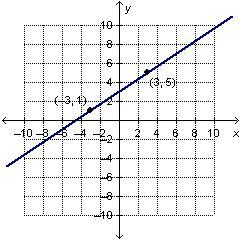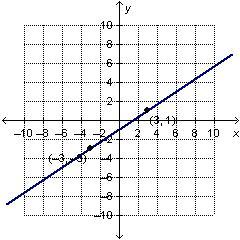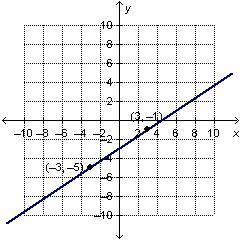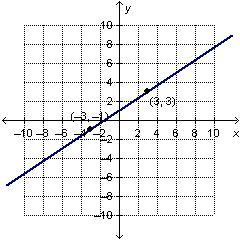Answers
Answer:
The second graph ( one with the coordinates (3,1) and (6,3))
Step-by-step explanation:
Answer:
The answer is B.
Step-by-step explanation:
Related Questions
PLEASE HELP ME ASAP I HAVE 4 QUESTIONS BRAINIEST TO WHO IS RIGHT
Answers
Answer:
B: Distinct lines
Step-by-step explanation:
If you go to desmos graphing calculator add put the equations in you can see they never interesct
Answer:
B) distinct parallel lines
Step-by-step explanation:
First, place both equations in slope-intercept form:
y + 6 = [tex]-\frac{1}{3}[/tex] (x - 15)
y + 6 = -1/3x + 5
y = -1/3x - 1
2x + 6y = 24
6y = -2x + 24
y = -2/6x + 4
y = -1/3x + 4
Because they have the same slope and different y-intercepts, they are parallel.
You can drive 607.5 miles with 15 gallons of gas. How many miles can you drive with 1 gallon of gas?
Screenshot below
Answers
Answer:
40.5
Step-by-step explanation:
Since there's no converting, you can just divide 607.5 by 15 to get the answer
What is the mean height of Bella's corn stalks?
A 69cm
B 75cm
C 78cm
D 80cm
E 81cm
Answers
Answer:
C. 78
Step-by-step explanation:
Add all of them together, then divide by 5 because there are 5 different plants.
X+4y=8 identify the x intercept
Answers
Answer: (8, 0)
Step-by-step explanation:
X intercept is when y = 0
[tex]x+4*0=8\\x=8[/tex]
BRAINLIEST
A type of mold doubles every 9 hours. If you started with 14 spores in a Petri dish, how many spores would you have after 45 hours? After 45 hours, there would be_______spores.
Answers
Answer:
448
Step-by-step explanation:
Every 9 hours, mold doubles
Started with 14 spores
In 9 hours, 14+14= 28 spores
In 18 hours, 28+28=56 spores
In 27 hours, 56+56=112 spores
In 36 hours, 112+112=224 spores
In 45 hours, 224+224=448 spores
We want to write an equation for an exponential growth that represents the change in the population of mold.
The answer is: "After 45 hours, there would be__448__spores."
-----------------------------------
We know that a given type of mold doubles every 9 hours.
So if you start with a quantity A of spores, after 9 hours there are:
2*A spores.
After another 9 hours (for a total of 18 hours) the population is:
(2^2)*A spores.
You already could see the pattern.
After x hours, the number of spores will be given by:
p(x) = A*(2)^(x/9)
Now we want to know how many spores are there after 45 hours, if the initial amount is 14 spores.
So we need to replace:
A = 14x = 45Then we want to compute:
p(45) = 14*(2)^(45/9) = 448
From this, we can conclude that after 45 hours there will be 448 spores.
If you want to learn more, you can read:
https://brainly.com/question/12490064
DUE TODAY AT 12! PLS HELP ALGEBRA WILL GIVE BRAINLIEST!
Answers
Answer:
Im gonna go with b not 100% tho
Step-by-step explanation:
A-55
B-65
C-75
D-90
Please help meee it’s a test
Answers
angle 2 = 90
180 (total degrees in a triangle) - 90 - 25 = 65
can anyone help me?
Answers
Answer:
Literally take your f(x) and - your g(x)
(x^2+9x+18) - (x + 6)
Remember to distribute the negative sign.
Select three ratios that are equivalent to
16
:
12
16:1216, colon, 12.
Choose 3 answers:
Choose 3 answers:
(Choice A)
A
8
:
6
8:68, colon, 6
(Choice B)
B
32
:
24
32:2432, colon, 24
(Choice C)
C
4
:
3
4:34, colon, 3
(Choice D)
D
12
:
8
12:812, colon, 8
(Choice E)
E
24
:
16
24:16
Answers
Answer:
A,B,C
Step-by-step explanation:
When you divide 16 by 12 you get 1.3 repeating. When you divide A , B , C by their numbers you get 1.3 repeating also. But D and E equal 1.5 so that's how you know those to answers are incorrect:)
glad to help!
The equivalent ratio are 8:6, 32:24 and 4:3
What is Ratio?A ratio is a comparison between two amounts that is calculated by dividing one amount by the other. The quotient a/b is referred to as the ratio between a and b if a and b are two values of the same kind and with the same units, such that b is not equal to 0. Ratios are represented by the colon symbol (:). As a result, the ratio a/b has no units and is represented by the notation a: b.
Given:
Ratio = 16 : 12
Simplifying the ratio
= 16/12
= 4/3
So, first 8:6
= 4: 3
and, second 32:24
= 4:3
and, third = 4:3
and, fourth 12 : 8
= 3:2
Hence, the equivalent ratio are 8:6, 32:24 and 4:3
Learn more about ratio here:
https://brainly.com/question/13419413
#SPJ5
In 2010, the continent of South America had a population of 395,280,204 . Which of the following is the closest estimate of this number
Answers
do you have answer choices? if so, the answer is whichever number is closest to 395,280,204
Answer:
C. 4x10^8
Step-by-step explanation:
Please help me I’m from Texas so I am stupid
Answers
Answer:
Given h(x) = -x + 2, find h(4).
Step-by-step explanation:
Answer:
Graph A
Step-by-step explanation:
Because the inequality is
[tex] \leqslant or \geqslant [/tex]
it means the line will be solid, not dashed. Also, because the y variable is on the less than side of the equation, it means the shaded are will be under the line.
Which statement is TRUE? A) The area of the blue circle is greater than the sum of the areas of the green square and black circle. B) The area of the blue circle is less than the sum of the areas of the green square and black circle. C) The area of the blue circle is equal to the sum of the areas of the green square and black circle. D) The area of the blue circle is twice the sum of the areas of the green square and black circle.
Answers
Answer:
C. The area of the blue circle is equal to the sum of areas of green square and black circle.
Step-by-step explanation:
The area of a circle is the circumference of the circle measured with its diameter. In the given scenario the area of the blue circle is greater than the area of black circle. This is because of the difference in diameter of the two circles. The area of green square plus the area of black circle equals the blue circle.
1. Which property could you use to change the order of the addends? Use commutative property to rearrange the addens. 2. Which property could you use to change the grouping of the addens 4) Simplify your sum to find the total amount of soup mix. Show your work.
Answers
Step-by-step explanation:
Hi, it seems the question is not complete, therefore I'll create an example tailored to the concept of the question you are asking.
1. Cumulative property can be used to change the order of addends and the result remains the same. Therefore the law states that, if a and b are real numbers, then a + b = b + a
Think about adding two numbers, such as 7 and 2.
7 + 2 = 9
2 + 7 = 9
The results are the same.
Notice, the order in which we add does not matter.
2. Associative property, this can be used to regroup addends and the result remains the same: the law states that, if a, b and c are real numbers, then
(a + b) + c = a + (b + c).
Think about three numbers, 4, 3 and 2
(4 + 3) + 2 = 7 + 2 = 9
4 + (3 + 2) = 4 + 5 = 9
The results are the same, notice that the regrouping did not change the final result.
Answer:
Thank You This Helped Alot!
Write the equation of the parabola in vertex form.
vertex (4,2), point (3,- 1)
f(x) =
Write the equation of the parabola in vertex form.
vertex (4,4), point (2,- 8)
f(x) =
Answers
Answer:
Step-by-step explanation:
poin
If a recipe calls for 4 1/2 cups of flour for 48 cookies, how much flour would be needed for 24 cookies?
Answers
Answer:
2 1/4 is the answer
Step-by-step explanation:
4 2/4÷2= 2 1/4
Answer:
2 1/4
Step-by-step explanation:
Set up a table with the labels flour and cookies on the flour side have 4 1/2 on the cookies side have 48 then in another row 24. Divide 24 by 48 to find out what to multiply 4 1/2 by to get the answer.48 divided by 24 is .5 so you would multiply 4 1/2 by .5 to get 2 1/4
Alejandra correctly wrote the equation y – 3 = y minus 3 equals StartFraction 1 Over 5 EndFraction left-parenthesis x minus 10 right-parenthesis.(x – 10) to represent a line that her teacher sketched. The teacher then changed the line so it had a slope of 2, but still went through the same point. Which equation should Alejandra write to represent the new line?
Answers
Answer:
y – 3 = 2(x – 10)
Step-by-step explanation:
Hope this helps!!!
It’s the first one that I need help with
Answers
Answer:
4x-3(6x-1)=-11Step-by-step explanation:
6x-y=1
-y=-6x+1
y=6x-1
4x-3y=-11
4x-3(6x-1)=-11Fill in the blank
A _______ equation is an equation whose graph is in a line.
Y divided by x equals ___________ proportionality.
A ____________ relationship has a constant rate of change and goes through the origin.
On a coordinate grid, the point (0,0) is called the ___________.
A ____________ relationship may have a constant rate of change but does not go through the origin.
plz help this is part of my homework i already did most of it but i could not remember this TwT
Answers
On a cordon are grid the point is 00 is called the origin .
If QR = 2x, RS = x + 7, and QS = 16, what is QR?
2x
R
x + 7
S
16
Answers
Answer: QR = 6 units
Step-by-step explanation:
QR + RS = QS
2x + x + 7 = 16
3x = 9
x = 3
QR = 2x = 2*3 = 6
Charlotte is in the business of manufacturing phones. She must pay a daily fixed cost to rent the building and equipment, and also pays a cost per phone produced for materials and labor. The labor and materials cost $100 for each phone manufactured, and the total cost of producing 8 phones in a day would be $1300. Write an equation for C,C, in terms of p,p, representing total cost, in dollars, of producing pp phones in a given day.
Answers
Answer:
C=100+162.5pStep-by-step explanation:
In this problem, we want to write a model/equation that will represent the cost of producing a phone
Given, labor and materials cost per phone is $100
the cost of producing 8 phones a day is $1300
let us find the cost of producing one phone a day
8 phone is produced for $1300
1 phone will be for x
x= 1300/8
x=$162.5
The cost of producing a phone in a day is $162.5
therefore the of producing p phone in a day is 162.5p
if C represents the total cost of producing a phone
then total cost, in dollars, of producing p phones in a given day.
C=100+162.5p
Answer: C = 100p + 500
This is the correct awnser
Step-by-step explanation:
Janice earned $725 dollars by working 5 days in a week. What is the average amount that she earned per day?
Answers
Answer:
She made an average of 145$ per day.
Step-by-step explanation:
If she earned 725$ in 5 days, just divide 725 by 5 for your average a day.
write an inequality for the following statement :
c is less than 1
Answers
Answer:
c < 1
Step-by-step explanation:
less than is <
c < 1
please answer i need help
Answers
Answer:
h < 2
Step-by-step explanation:
Given
5(2h + 8) < 60 ( divide both sides by 5 )
2h + 8 < 12 ( subtract 8 from both sides )
2h < 4 ( divide both sides by 2 )
h < 2
Answer:
h<2
Step-by-step explanation:
5(2h+8)<60
2h+8<12
2h<4
h<2
Someone help me please❤️
Answers
Inputs : -2,-1,0,1
Outputs: -7,-4,-1,2
Answer:
inputs: outputs:
-2 -7
-1 -4
0 -1
1 2
Step-by-step explanation:
Input=domain and x so, plug domains in for x in the equation to get each output.
input equation output
-2 y=3(-2)-1 -7
-1 y=3(-1)-1 -4
0 y=3(0)-1 -1
1 y=3(1)-1 2
jerry has 5115 in his savings account and $65 dollars in his checking account If Jerry deposits 520 to his savings account each week and 545 to his checking
account each week, how many weeks will it be until the two accounts have the same amount of money?
Answers
Answer:
I
Step-by-step explanation:
Individual computer lab sessions at a school are 24 minutes long. On Monday, 313 students each completed a session at the computer lab. What is the total number of minutes the students spent at the computer lab?
Answers
Answer:
7512 minutes
Step-by-step explanation:
313 students each completed a 24 minute session. Which would be
313 · 24 = 7512
hope this helps... please amkr brainliest answer if correct:)
-2[3x–(4x–5y)–2(3x-4y)]
Answers
But if you need the steps let me know!
the place value of 2 in 5.32 is
Answers
Answer: hundredths
Step-by-step explanation:
The second number past the decimal point is the hundredths place
LOOK AT THE IMAGE ABOVE AND SOLVE IT FOR TWO DIFFERENT WAYS!! Please help its due today!
Answers
Answer:
Step-by-step explanation:
Ist method - Area of the triangle + Area of the trapezium
Area of triangle = 1/2 × b × h
here, b = 8 cm but h is not given
so we will find h by pythagoras theorem
AC^2 = AB^2 + BC^2
10^2 = 8^2 + BC^2
100 = 64 + BC^2
BC^2 = 36
BC = √36
BC = 6
∴ h = 6cm
area of triangle = 1/2 × b × h
= 1/2 × 8 × 6
= 24 cm^2
Area of trapezium = 1/2 ( a + b ) h
Here a = 13cm
b = 25 - 8 = 17 cm
h = 6 cm
So area = 1/2 ( a + b ) h
= 1/2 ( 13 + 17 ) 6
= 90 cm^2
So total area = Area of the triangle + Area of the trapezium
= 24 cm^2 + 90 cm^2 = 114 cm^2
2nd method - Area of the entire figure
Since the figure is a trapezium,
Area of trapezium = 1/2 ( a + b ) h
here, a = 13cm
b = 25 cm
h = 6 cm
Area of trapezium = 1/2 ( a + b ) h
= 1/2 ( 13 + 25 ) 6
= 114 cm^2
Hope this helps
plz mark as brainliest!!!!!!!!!!
answer:
not a very clear diagram sorry luv but i just cant really see the question <3
step-by-step explanation:
a plus zero equals a is an example of which addition property
Answers
Answer
:Identity Property of Addition
Step-by-step explanation:



